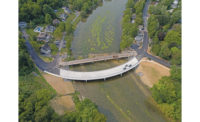HDR's health-care work is not only noteworthy in the region—HDR is ranked as the ENR Texas & Louisiana top firm in the health-care sector—the Dallas office portfolio includes many of the company's largest health-care projects nationally. Other notable HDR sector projects include the $438-million University of Texas Medical Branch Jennie Sealy hospital replacement in Galveston and the $100-million Sheikh Zayed Bin Sultan Al Nahyan Building for Personalized Cancer Care, which broke ground in November.
That success hasn't gone unnoticed. Last year, Hank Adams served as health-care principal in the Dallas office, representing work just in the region. In January, he was promoted to national director of health care. "Part of the reason I was promoted was based on what we have accomplished in Dallas," he says. "There was recognition that we built a great culture and a successful model that the firm wants to emulate nationally."
Adams says the Dallas practice is committed to a servant-leadership model, which emphasizes the value of team members and promotes collaboration. He says it's a natural fit in an employee-owned firm. "Everyone has bought in and has a personal stake in the success of the office," he says. "People aren't waiting for someone else to tell them what to do. Everyone is empowered."
Engineered for Success
While the architecture side of HDR's business grew, the firm's engineers kept pace as well. HDR tops this year's regional civil engineering ranking with $95.83 million in revenue. Contributing to that tally is a wide range of work in transportation (ranked #3), water supply (ranked #3) and power (ranked #2).
In transportation, HDR remains in the mix of recent megaprojects throughout the state, including the PGBT-Western Extension (SH 161) in Dallas and the IH 45/IH 610 Interchange in Houston. Miquez sees big potential for more highway and bridge work in the near future, as the state considers several public-private partnerships.
"You look at what's on the street now, [Texas] is proceeding with large scale projects through the PPP approach," he says. "There are projects with the potential for revenue generation. We've got several of those brewing right now."
Both freight and commuter rail have proven surprisingly strong in recent years as well. In transit, the firm has worked on streetcar studies for Dallas Area Rapid Transit and on commuter rail feasibility studies in Houston. Near Fort Worth, the firm is wrapping up design of improvements to Tower 55, which is an infamous bottleneck in the national rail system.
Miguez notes that, in light of increased interest in rail planning at the state level, he sees improving opportunities in rail in the coming year. "It's clear that the state as a whole has come to the realization that we need a multimodal approach," he says.
Another expanding market that HDR is capitalizing on is port work. Neil Graff, south Texas area manager for HDR, says the push to export product from Eagle Ford shale is prompting maritime improvements. "We're seeing robust opportunities coming out of Corpus Christi for ports and harbor work, spun off from the oil and gas production in Eagle Ford," he says. "That's on top of our work for the Navy and the U.S. Maritime Administration."






Post a comment to this article
Report Abusive Comment